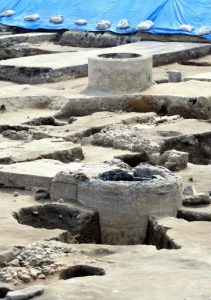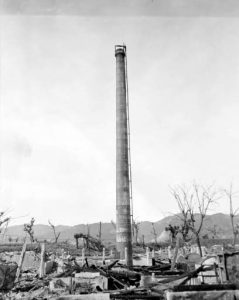Striving to fill voids in Hiroshima—Tragedies of war and A-bombing etched into remnants of expansive military facility, serving as ‘wartime witness’
Jun. 26, 2021
A-bombed remnants of military base unearthed at planned site of new soccer stadium are opened to media
by Kyosuke Mizukawa, Staff Writer
An excavation site in the inner space of Hiroshima’s Central Park in the city’s Naka Ward, where a new soccer stadium is to be built, was opened to the media on June 25. Etched into A-bombed remnants discovered at the site of the former Japanese Army’s transport unit known as the Chugoku District transport soldier recruitment unit (“Shichotai” in Japanese) are both Hiroshima’s history of pre-war modernization as a “military city” starting with the Meiji period, as well as its searing memories of war and the atomic bombing.
Among the artifacts unearthed in the eastern part of the excavation site are traces of barracks where Shichotai unit members lived, restroom facilities, and concrete steps assumed to have been used in training exercises for jumping from elevated positions. The findings conjure a slice of daily life at the expansive military facility, which is said to have housed about 1,000 service members during World War II.
The large-scale military facility was spread out over an area that reached within one kilometer of the hypocenter and was totally destroyed in the atomic bombing. A photograph of the site taken after the bombing shows that a chimney located near the kitchen and bathing facilities was about all that remained among the ruins. During our reporting, the Chugoku Shimbun was able to identify a remnant assumed to be traces of the chimney depicted in the same photo in the western part of the excavation site. Linking the photos with the actual remnants might to be a good way to effectively convey the actual situation of the site at the time of the atomic bombing.
The unit’s artifacts are valuable, and as a result, many have voiced calls for an on-site briefing session to be held to explain things to citizens. While viewing the scene of the remnants being made available to the media from over a surrounding fence, Tetsuo Kaneko, 72, a representative committee member for the Hiroshima prefectural chapter of the Japan Congress against A- and H-Bombs (Gensuikin), reiterated his demand that the city government “Hold an onsite explanatory session for citizens as soon as possible.”
(Originally published on June 26, 2021)









